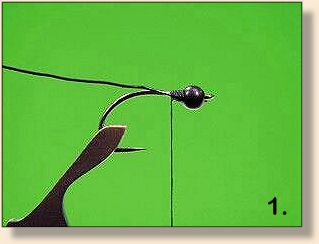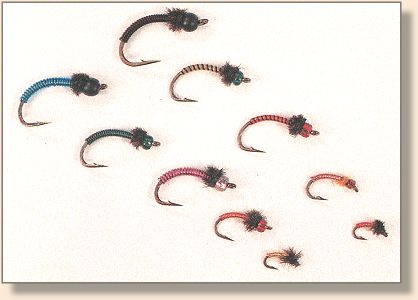The 'Cu'-Ronomid
By Sheldon Seale
One of the very first nymphs I ever saw was an
ingenious little pattern with a body of bright
copper wire, called a Brassie. As a novice fly fisher,
I used a Brassie from time to time, in both still and
moving water, with good success.
The Brassie had its genesis on Colorado's South Platte
River in the 1960s, when Ken Chandler, Tug Davenport, and
Gene Lynch collaborated in using flies with copper wire bodies.
The pattern was simple: a bright copper-wire abdomen with a
thorax of thread, dubbed fur, peacock herl, or even shrink
tube. One of the key features of the pattern was that the
copper wire should be bright. Consequently, the collaborators
recommended tying only a few flies at a time so that they
wouldn't tarnish. Some commercially tied Brassies even came
in small vials of liquid gelatin, which prevented tarnishing
even after years on the shelf.
The Canadian 'Cu'-Ronomid
The 'Cu'-Ronomid is a Brassie variation tied on a scud or
shrimp hook to imitate chironomids and, while others have
used copper wire for chironomid patterns (particularly in
British Columbia), it has a couple of features which are
unique. Like the original Brassie, the pattern is elegantly
simple: just wire, a bead, and peacock herl. The availability
of copper wire lacquered in red, green or black and a wide
range of beadheads enables a wide range of variations in both
colour and sink rate. Here, in Ontario, it's proved very
effective on lakes and ponds, for trout and a variety of
other species. A good friend with whom I shared the pattern
suggested incorporating "Cu" (the atomic symbol for copper)
in the name-and it seems to have stuck.
Recipe - The Black Deep-water Express Variant
Hook: Fine wire scud or shrimp, sixes 10-22.
Thread: to match body color 6/0.
Abdomen: Lacquered copper wire, 26 - 34 gauge, to match
hook size, colour of choice.
Thorax: Peacock Herl.
Tying Instructions

1. Slip a black metal bead on the hook (size #10).
Set the hook in the vice at the bend. Start the thread
immediately behind the bead and secure a length of black
coated wire for the body.

2. Making sure to leave a small gap behind the bead,
form the abdomen by wrapping the wire down the hook
toward the bend in touching turns. When you've formed
a nice curve around the bend of the hook, trim off the
excess wire.

3. Secure five or six strands of peacock herl in the gap
between the abdomen and the bead.

4. Twist the herl into a rope and wrap a short thorax.
Secure this with two or three turns of thread and trim
the excess herl. Tie off behind the bead with a
three-to-four-turn whip finish. Trim the excess thread
and the fly is complete.
Note: Some wire is too stiff to be tied in. If
the wire pulls out when you try to wrap it - no matter
how firmly you tie it in - remove the thread and start
the wire at the bend of the hook. Hold some of the wire
between your thumb and index finger and wrap the wire in
touching turns forward to form the abdomen. Leave a small
gap between the abdomen and the bead. Trim the wire twice,
at the bend and behind the Bead. Now start your thread
behind the Bead, trap the wrap of wire closest to the Bead
with a couple of turns of thread and continue with step #3.

By the way, I will use snowshoe rabbit foot hair anywhere that calls for a short length
of Antron yarn or a tuft of CDC.
A Word On Beads
There are many varieties of beads on the market suitable for this
style of fly. Most craft shops carry some. For extra sparckle,
try Rochaille-style beads. These beads have a silver lining in
the hole for better light reflection/refraction. Small Seed
Beads are good in sizes 16 to 18. If you look carefully you can
find these also in Rochaille style. Try Petite Beads for even
smaller patterns (sizes 20 to 22). Bead colours to get are black,
red,green, brown, orange, copper and clear (or pearlescent).
A Word On Wire
Recently, Wapsi introduced a new line of copper wire called
UltraWire. At a three dollars or so a spool, it's a relatively
inexpensive source of material for an almost endless series of
patterns. It's available in a host of colours and in two gauges,
fine (sometimes listed as BR) and medium. There are other
sources of wire, including lamp wire and old electric motor
windings. Industrial copper-coloured wire seems to come in
three shades, clear (or bright), medium and dark. All work
well. The most useful gauges are between 26 and 32. Use 26
gauge for hook sizes 10 and 12, 28 gauge for hook sizes 10-16
(the best all round size for the 'Cu'-Romonid), 30 gauge for
hook sizes 16-20, and 32 gauge for hook sizes 18-22. I've
found the most useful colours are black, red, green, brown
(medium and dark copper), bright copper, orange, claret (wine),
chartreuse and gray/white. But I'm always ready to experiment
with others.
The basic difference between the 'Cu'-Ronomid and the Brassie,
besides the hook type and the bead, is the manner in which
the wire is tied in. In the original Brassie, the wire was
secured along the hook shank and the body was formed by
wrapping the wire forward to the thorax. In the 'Cu'-Ronomid,
the wire is secured only at the thorax end, relying solely
on the relative stiffness of the material to stay in place
at the bend of the hook. It's important, therefore, that
you wrap the wire very tightly. However, should the wire
loosen up and slide around the bend while you're fishing,
just push it back in place and give the wire a twist with
your hand. It will still be quite useable.
Variations:

There are almost endless variations to the 'Cu'-Ronomid. For
instance, using more than one strand of wire (up to three)
provides some interesting enhancements of the segmentation
effect. You can also use contrasting colours for the beadhead
and the abdomen-a red beadhead with black wire, for example.
The Deepwater Express, featured in the tying instructions, is
a fast-sinking variation that really gets down deep in a hurry.
I generally name the pattern by colour. For example, the Black
'Cu'-Ronomid has both a black beadhead and black wire abdomen.
In a two-colour variant, the colour of the abdomen is given first.
Therefore, the Red & Black 'Cu'-Ronomid has a red abdomen with a
black bead. Some variants have been given nicknames. The Blue
'Cu'-Ronomid is sometimes referred to as the Icicle 'Cu'-Ronomid
because it works well in the cold, clear water of winter.
Fishing notes:
While the 'Cu'-Romonid can be fished conventionally as a nymph
in both rivers and stillwaters, it is at its most effective on
stillwaters either fished suspended or on a slow lift. My favorite
method is to suspend the fly under an indicator (or a large dry
fly) at the depth where the fish are holding. If the
indicator/fly gets 'nervous' or dips under, set the hook with
a straight upward sweep of the rod. You will usually hook the
fish right at the snout in the upper jaw. This approach has
proven effective down to depths of about eight to nine feet
(2.5 meters).
The other approach I've used is effective for fish that are
down ten feet or more (more than 2.5 meters). I use a team of
up to three of 'Cu'-Ronomids on a leader (where allowed) and
get them down deep quickly with a sinking or sink tip line.
Using a hand-twist type retrieve, I fish them very slowly.
You only want enough movement to keep the line sufficiently
taut to feel the take. Sometimes the take can be so light
that it's not the weight of the fish you feel, but an absence
of the weight of your line and flies (if you're in a boat or
float tube, you have to be well-anchored to notice this effect).
Other times, the fish will take "with authority". In any case,
a short set will be sufficient to hook up.
The 'Cu'-Ronomid pattern works well on many different fish
species. Trout are obvious but any fish that will feed on
midge larvae, in still or moving water, will take this pattern.
Even those tough-to-catch big Sunfish will greedily gulp down
a well-placed Green or Black 'Cu'-Ronomid. The 'Cu'-Ronomid
is also a pretty fair imitation of some Caddis larvae and
shouldn't be overlooked when the fish are feeding on them.
To illustrate the pattern's versatility, this past winter
some friends of mine found that the Icicle (blue) 'Cu'-Ronomid
was very effective for crappie fished through the ice on
light jigging gear! ~ Sheldon Seale
|






